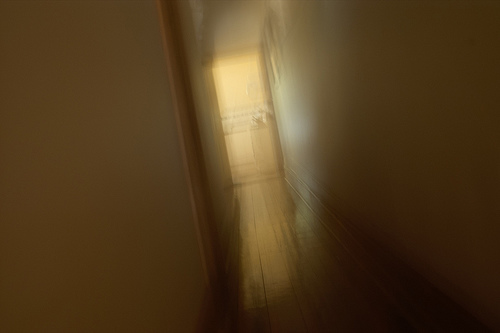Mack Gelber
The Mystery of the Cake
In this mystery, a series of disappearances rocks the small town of Dunning, Michigan. One by one the children of Dunning vanish from their bedrooms. Each time, the only clue is a mysterious photocake left on the floor of the scene, a single supermarket candle still burning in the center. Each cake bears an image of the disappeared, surveillance-style shots of children boarding school buses, standing in kitchen windows, gazing out at some distant, unseen observer. Sometimes the cakes have vanilla frosting, sometimes chocolate buttercream. One is enrobed in a medley of crushed nuts investigators determine to be mostly pistachios. The children are never found.
The Mystery of the Pond
In this mystery, a 40-foot shipping container appears overnight on the frozen pond behind Hazel Billings’ house. The words 连雀 HEAVY INDUSTRIES are stamped onto the outer wall, and inside is a shipment of approximately 200,000 red spheres, each about the size of a Ping-Pong ball but as smooth and heavy as a piece of marble. No one can say where the shipping container came from or how it ended up on the pond, or why Hazel Billings has begun to walk out onto the ice at night, carrying an unzipped backpack.
The Mystery of the Babysitter
In this mystery, Ed and Christine Halstead hire a local teenager to babysit their son, a 12-year-old with a severe behavioral disorder who cannot be left alone. The first time she comes over, the babysitter sits watching TV on the couch beside the boy, Eric, who never speaks. But soon she begins to sift through the Halsteads’ drawers and closets, leafing through Chinese takeout menus or reading the directions on the side of a prescription bottle. One night she discovers a photo wedged into the spine of a dusty almanac. It’s a picture of the Halsteads’ son standing on a beach, surrounded by smiling faces—not the Halsteads, but another, younger family. Written on the back: “Brian, with parents.” An unfamiliar voice calls out from the other room.
The Mystery of the Box
In this mystery, a man returns home from work to find an unusual package on his doorstep. It’s a box, with no label or writing of any kind except for a lone sticker with a barcode, and when he opens it dozens of Styrofoam packing peanuts spill out onto the floor. At the bottom, his hand closes around a single red sphere, about the size of a Ping-Pong ball but as smooth and heavy as a piece of marble. He picks it up and examines it, then checks again for the box’s return address. There is none. That night, before falling asleep, he places the sphere on his nightstand. In the week that follows, strange things begin to happen to him.
The Mystery of the Voice
In this mystery, Jenny’s boyfriend starts talking in his sleep. He expounds at length on art, architecture, and music theory, topics of which he has no knowledge in waking life. For example, he offers up details of a specific building in a Spanish city called Zaragoza, providing an extended description of its dense concrete facade and unusual hexagonal windows. By sunrise, the boyfriend, whose name is Brent, recalls nothing. When Jenny asks him about the building in Spain, he thinks she’s talking about something they saw on House Hunters International. “Left the country?” he says. “I’ve barely left Ohio.” Gradually, she finds herself counting down the hours until nightfall, for the moment when dull, unsophisticated Brent becomes worldly, digressive not-Brent. Then, one day, Brent (Brent-Brent, not not-Brent) tells her he’s decided he wants to break up. She’s not sad; not really.If anything, she’s a little relieved. Still, there’s a part of her that was anticipating the next lyrical utterances of not-Brent, that compels her to start listening to YouTube lectures on midcentury architecture as she falls asleep. The same part of her that, some weeks later, impulsively books a flight to Zaragoza, which requires a 12-hour layover in Ghent and eats up a month’s worth of paychecks. It takes her two days to find the building, and when she does it’s exactly as he described: the poured concrete walls, cool to the touch, and the hexagon windows, colored by green glass. She walks along the perimeter, trying to locate the entrance. But like he said, there is no door.
The Mystery of the Cat
In this mystery, an old lady loses her cat. She tries to find the cat. She cannot find the cat.
The Mystery of the Hotel
In this mystery, it’s Christmas Eve at a freeway Marriott somewhere off I-80. The hotel is totally snowed in, the bar empty except for two bald men wearing sneakers. For a time, one glances occasionally at the other, trying to place what’s familiar about him. Finally, he walks over and carefully lowers himself onto the adjacent stool. “Brian?” The second man looks up from the bar, gradually meeting the first one’s gaze. His face is entirely expressionless, his stare machinelike. A moment passes. Another moment passes. Behind them the bartender cleans glasses and silently repositions bottles on the shelf. Outside, the wind roars as snow covers the vast flatness surrounding the hotel, slowly erasing the land, the trees, the highway. Eventually, the second man smiles and opens his hand. Inside, a red sphere.
The Mystery of the Overpass
In this mystery, two drug addicts roam the city in a burnt-out Corolla. They’re using one of those mobile delivery apps to earn money, picking up people’s meals at restaurants and bringing them to their door. They deliver quarter pounders to some college students in a frat house. They bring a salad up to someone’s office. After a few runs, they get a request for pickup at a Spanish-American restaurant on the outskirts of town. Inside, an unsmiling man hands over a small cardboard box. There’s no label or writing of any kind, and it’s sealed with heavy aluminum tape. Their instructions tell them to drive 20 minutes to a crumbling overpass, where they find an unlocked circuit panel that’s been hollowed out on the inside. A strange word has been scored into the metal cover: ZARAGOZA. They place the box in it, and moments later receive a deposit of $200,000. Within 24 hours, both of them are dead.
The Mystery of the Cat, Pt. 2
Weeks pass. The old lady continues to search for the cat, pinning “missing” signs up on telephone poles around town and the bulletin board on the wall at Coffee Union. She wanders the streets, calling the cat’s name in a cheerful voice. She cannot find the cat.
The Mystery of the Gas Station
In this mystery, a couple on a road trip pulls up to an old gas station. The place looks semi-deserted but the pumps are working, and Lucy heads into the Quik Shop for snacks and water. Inside, she notices the refrigerators have been unplugged and the racks of food wiped clean. She wanders to the back of the empty store looking for the bathroom, but only finds a corridor leading to a cramped office with a plastic folding table and some chairs. On the table there’s a birthday cake—it’s one of those supermarket photocakes, with a blurry image of a four or five-year-old boy lasered into the frosting. A single candle burns in the center. The boy has brown hair and is wearing a t-shirt that’s too big for him, hanging around his ankles like a potato sack. He seems to be looking at something just beyond the frame, the angle of his gaze directed a few inches over Lucy’s shoulder. She shivers, turns around. There’s no one there.
The Mystery of the Secret Passage
In this mystery, Carl rents a post hole digger and begins to drill into the floor of his house. He is drilling into the floor of his house because he is insane, convinced fumes passing through the porous foundation are giving him cancer. After several hours, he hits a piece of metal that sends a recoil through the machine and throws him off balance. The metal appears to be the top of some kind of underground vent, and when Carl bends down he finds a single sliding panel. He forces it open and shoulders his way in. The inside of the vent is dark, but there’s enough room for him to grind his way forward on his knees, struggling, dragging himself by the strength of his fingertips, dirt and construction debris and corroded flakes of metal becoming lodged beneath his nails, the light inside the vent narrowing to a point and then vanishing entirely, grinding forward in the dark, struggling, insane, inhaling fumes from the planet’s core, cancer-stricken, rheumatic, an imagined ringing in his ears, small eyeless creatures shuddering and flicking their mandibles, machinelike, expressionless, mostly pistachios, as smooth and heavy as a piece of marble.
Zaragoza
In this mystery –
The hexagon windows, colored by green glass.
The vast flatness surrounding the hotel.
Written on the back: “Brian, with parents.”
Dozens of Styrofoam packing peanuts spill out onto the floor.
Inside, a man hands over a cardboard box.
Inside, she notices the refrigerators have been unplugged and the racks of food wiped clean.
Inside is a shipment of approximately 200,000 red spheres.
The children are never found.
But like he said, there is no door.
The Mystery of the Cat, Pt. 3
Weeks pass. Weeks pass. Weeks pass. Weeks pass. Weeks pass. Weeks pass. Weeks pass. Weeks pass. She cannot find the cat.
Mack Gelber’s fiction has appeared in publications including Hobart, Neon, Vol. 1 Brooklyn, and Identity Theory. He lives with his wife and two dubiously trained lab mixes in Columbus, Ohio, and works as a branded content writer and editor at The Wall Street Journal. Follow his infrequently updated Twitter at @mackgelber.


